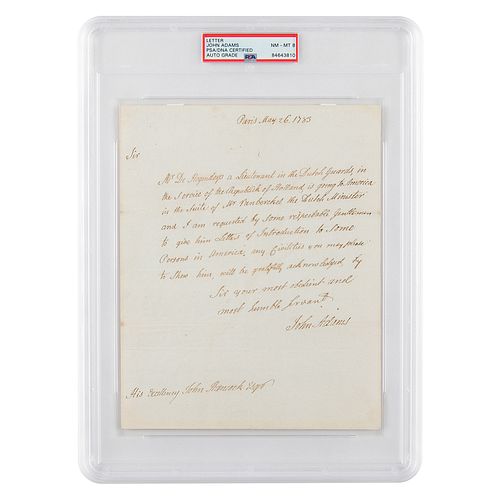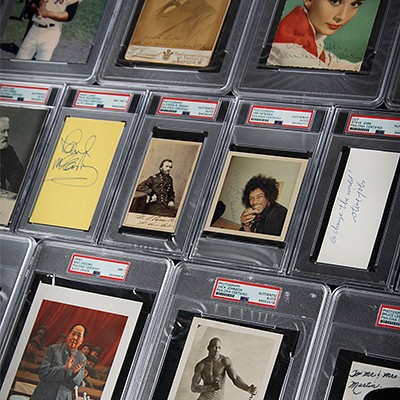John Adams Autograph Letter Signed to John Hancock - PSA NM-MT 8
Two ways to bid:
- Leave a max absentee bid and the platform will bid on your behalf up to your maximum bid during the live auction.
- Bid live during the auction and your bids will be submitted real-time to the auctioneer.
Bid Increments
| Price | Bid Increment |
|---|---|
| $0 | $5 |
| $50 | $10 |
| $200 | $25 |
| $500 | $50 |
About Auction
Sep 22, 2022
RR Auction support@rrauction.com
- Lot Description
Revolutionary War-dated ALS signed “John Adams,” one page, 7.25 x 9.25, May 26, 1783. Significant handwritten letter to "His Excellency John Hancock," sent from Paris while awaiting the final signing of the Treaty of Paris. In full: "Mr. De Hogendorp, a Lieutenant in the Dutch Guards, in the Service of the Republick of Holland, is going to America in the Suite of Mr. Vanberkel the Dutch Minister and I am requested by some respectable Gentlemen to give him Letters of Introduction to some persons in America. Any civilities you may please to show him will be gratefully acknowledged." In fine to very fine condition. Encapsulated and graded by PSA/DNA as "NM-MT 8."
Provenance: Christie's, Property from a California Collector, June 18, 2007.
John Adams traveled to the Dutch Republic and settled in Amsterdam in mid-1780, where he hoped to transform a pro-American sentiment into a substantial loan, thereby lessening American reliance on France. However, fearing reprisal from the British, the Dutch government refused to even meet with him for more than eight months. In spite of these political difficulties, Adams never relented. When news of America's triumph at Yorktown reached Europe, Adams petitioned at The Hague for official recognition of American independence, and continued to badger them for a loan. As a result of these efforts, on April 19, 1782, the Netherlands became the second nation in Europe, after France, to recognize the sovereignty of the United States. Adams was then able to negotiate a loan of five million guilders, a treaty of amity and commerce, and establish the first American embassy on foreign soil.
On March 4, 1783, Dutch politician Pieter Johan van Berckel was made the first minister plenipotentiary to the United States of America. In writing to congratulate him on the appointment, Adams offered some guidance: 'My Advice would be to land at Boston, & take the Journey to Philadelphia, while you send your Frigate round by Sea to that City—This will give you an Opportunity of seeing a great part of the United States, and of becoming acquainted with many principal Characters. I will be answerable for your cordial Reception every where. His Excellency the Governor of Massachusetts, Mr. Hancock, and his Honor the President of the Senate, Mr. Samuel Adams, will receive You at Boston—Governor Trumbull at Connecticut—General Washington and Governor Clinton at New York—Governor Livingston at New Jersey. I would by all means advise You to pass through New York and New Jersey, where You will find Multitudes charmed at the Sight of a Dutch Minister more than any other in the World.'
With this letter, he introduces Gijsbert Karel van Hogendorp, a member of van Berckel's delegation, to his old friend, Governor John Hancock. During his travels in America, van Hogendorp would befriend Thomas Jefferson and spend time in the company of the Washingtons at Mount Vernon. Van Hogendorp would return to the Netherlands and hold several offices as an influential liberal statesman.
At the same time he was connecting his Dutch friends to their American counterparts, Adams was hard at work negotiating the Treaty of Paris as part of a delegation that included Benjamin Franklin and John Jay. The treaty to officially end the Revolutionary War was drafted on November 30, 1782, and finally signed at the Hôtel d'York in Paris on September 3, 1783, by Adams, Franklin, Jay, and British negotiator David Hartley.
Autograph letters from Adams to Hancock are exceedingly rare: in 1987, R. A. Ryerson, editor of the Adams Papers, identified this as one of only 13 extant letters of Adams to Hancock. Nine of these are in the Adams Papers, three are owned by other institutions, and only one other item—an account statement—remained in private hands at that date. - Shipping Info
-
Bidder is liable for shipping and handling and providing accurate information as to shipping or delivery locations and arranging for such. RR Auction is unable to combine purchases from other auctions or affiliates into one package for shipping purposes. Lots won will be shipped in a commercially reasonable time after payment in good funds for the merchandise and the shipping fees are received or credit extended, except when third-party shipment occurs. Bidder agrees that service and handling charges related to shipping items which are not pre-paid may be charged to a credit card on file with RR Auction. Successful international Bidders shall provide written shipping instructions, including specified Customs declarations, to RR Auction for any lots to be delivered outside of the United States. NOTE: Declaration value shall be the item’(s) hammer price and RR Auction shall use the correct harmonized code for the lot. Domestic Bidders on lots designated for third-party shipment must designate the common carrier, accept risk of loss, and prepay shipping costs.
-
- Buyer's Premium



 EUR
EUR CAD
CAD AUD
AUD GBP
GBP MXN
MXN HKD
HKD CNY
CNY MYR
MYR SEK
SEK SGD
SGD CHF
CHF THB
THB











